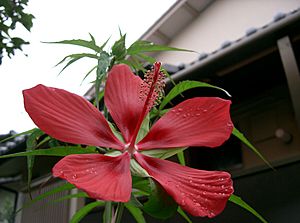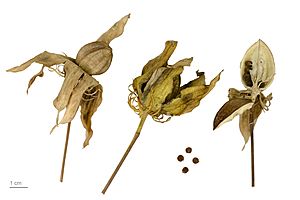Scarlet rosemallow facts for kids
Quick facts for kids Scarlet rosemallow |
|
|---|---|
 |
|
| Conservation status | |
| Scientific classification | |
| Genus: |
Hibiscus
|
| Species: |
coccineus
|
| Synonyms | |
|
|
The Hibiscus coccineus, also known as the scarlet rosemallow, is a beautiful and strong type of Hibiscus plant. People also call it the Texas star, brilliant hibiscus, or scarlet hibiscus. It is famous for its bright red, star-shaped flowers.
This plant naturally grows in wet places. You can find it in swamps, marshes, and ditches. It lives along the coast of the southeastern United States. Its native home stretches from southeastern Virginia down to Florida. It also goes west to Louisiana. Even though it's called "Texas Star Hibiscus," it doesn't naturally grow in Texas. Besides the common red flowers, there is also a white version. This white plant is sometimes called the white Texas star or lone star hibiscus.
Contents
What is the Scarlet Rosemallow?
The Hibiscus coccineus is a plant that comes back every year. It is called a herbaceous perennial. This means its top part dies in winter. But its roots stay alive underground. New growth appears in the spring. It can grow quite tall, usually between 6 to 8 feet high.
Leaves and Flowers
The leaves of this plant are shaped like a hand with fingers. They are called palmately compound leaves. Each leaf can be about 5 to 6 inches wide. The flowers are a bright scarlet red. They have five petals and look a lot like hollyhock flowers.
These striking flowers attract many different creatures. They are a favorite for hummingbirds, butterflies, and bees. One special bee, called Ptilothrix bombiformis, loves these flowers.
Growing Conditions
The scarlet rosemallow likes to grow in sunny spots. It also needs soil that stays moist. This plant is quite tough. It can grow well in USDA hardiness zones 6 through 9. This means it can handle cold winters in those areas.
What Does the Name Mean?
The scientific name coccineus comes from Latin. It means "colored or dyed scarlet," which perfectly describes its bright red flowers. The word Hibiscus is an old Greek and Latin name. It was used for plants in the "mallow" family.
See also
 In Spanish: Hibiscus coccineus para niños
In Spanish: Hibiscus coccineus para niños



